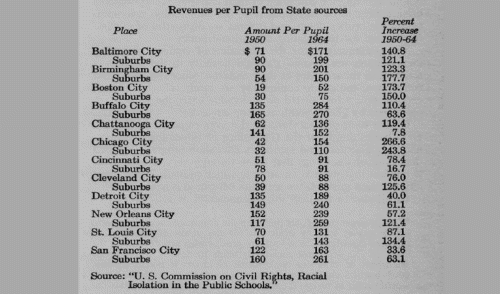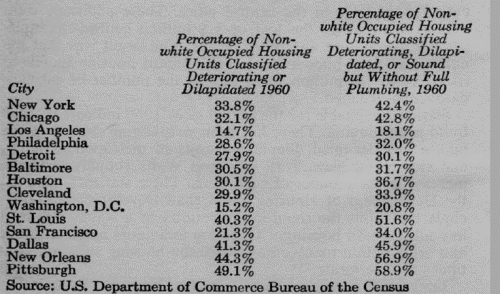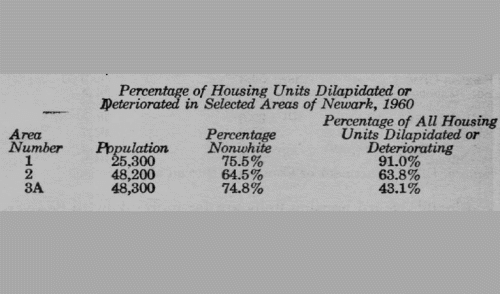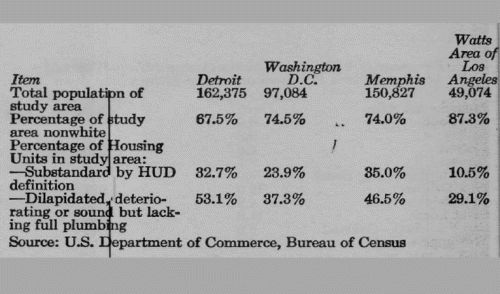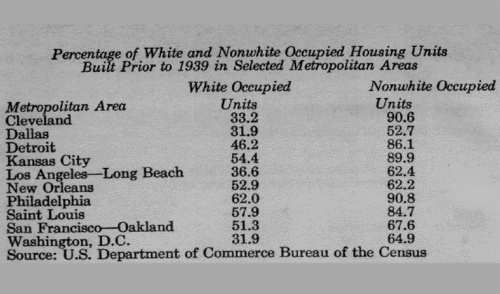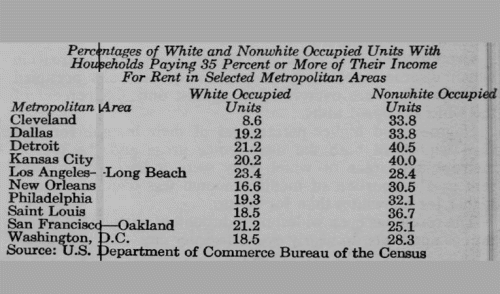Chapter 17: Recommendations for National Action
INTRODUCTION
The Commission has already addressed itself to the need for immediate action at the local level. Because the city is the focus of racial disorder, the immediate responsibility rests on community leaders and local institutions. Without responsive and representative local government, without effective processes of interracial communication within the city, and without alert, well-trained and adequately supported local police, national action -- no matter how great its scale -- cannot be expected to provide a solution.
Yet the disorders are not simply a problem of the racial ghetto or the city. As we have seen, they are symptoms of social ills that have become endemic in our society and now affect every American -- black or white, businessmen or factory worker, suburban commuter or slum dweller.
None of us can escape the consequences of the continuing economic and social decay of the central city and the closely related problem of rural poverty. The convergence of these conditions in the racial ghetto and the resulting discontent and disruption threaten democratic values fundamental to our progress as a free society.
The essential fact is that neither existing conditions nor the garrison state offer acceptable alternatives for the future of this country. Only a greatly enlarged commitment to national action -- compassionate, massive and sustained, backed by the will and resources of the most powerful and the richest nation on this earth -- can shape a future that is compatible with the historic ideals of American society.
It is this conviction that leads us, as a Commission on Civil Disorders, to comment on the shape and dimensions of the action that must be taken at the national level.
In this effort we have taken account of the work of scholars and experts on race relations, the urban condition and poverty. We have studied the reports and work of other commissions, of congressional committees and of many special task forces and groups both within the government and within the private sector.
Financing the Cost
The Commission has also examined the question of financing; although there are grave difficulties, we do not regard them as insoluble. The nation has substantial financial resources -- not enough to do everything some might wish, but enough to make an important start on reducing our critical "social deficit," in spite of a war and in spite of current requirements.
The key factors having a bearing on our ability to pay for the cost are the great productivity of the American economy, and a Federal revenue system which is highly responsive to economic growth. In combination, these produce truly astounding automatic increases in Federal budget receipts, provided only that the national economy is kept functioning at capacity, so that actual national income expands in line with potential.
These automatic annual increases -- the "fiscal dividend" -- from the Federal revenue system range from $11 to $14 billion under conditions of steady economic growth.
The tax surcharge requested by the President would add about $19 billion to a total fiscal dividend of about $28.5 billion over a two-year period.
While competing demands are certain to grow with every increase in federal revenues, so that hard choices are inevitable, these figures demonstrate the dimension of resources -- apart from changes in tax rates -- which this country can generate.
Federal Program Coordination
The spectacle of Detroit and New Haven engulfed in civil turmoil despite a multitude of federally-aided programs raised basic questions as to whether existing "delivery system" is adequate to the bold new purposes of national policy. Many who voiced these concerns overlooked the disparity between the size of the problems at which the programs are aimed and the level of funding provided by the federal government.
Yet there is little doubt that the system through which federal programs are translated into services to people is a major problem in itself. There are now over 400 grant programs operated by a broad range of federal agencies and channeled through a much larger array of semi-autonomous state and local government entities. Reflective of this complex scheme, federal programs often seem self-defeating and contradictory: field officials unable to make decisions on their own programs and unaware of related efforts; agencies unable or unwilling to work together; programs conceived and administered to achieve different and sometimes conflicting purposes.
The new social development legislation has put great strain upon obsolescent machinery and administrative practices at all levels of government. It has loaded new work on federal departments. It has required a level of skill, a sense of urgency, and a capacity for judgment never planned for or encouraged in departmental field offices. It bas required planning and administrative capacity rarely seen in statehouses, county courthouses and city hall.
Deficiencies in all of these areas have frustrated accomplishment of many of the important goals set by the President and the Congress.
In recent years serious efforts have been made to improve program coordination. During the 1961-1965 period, almost 20 executive orders were issued for the coordination of federal programs involving intergovernmental administration. Some two dozen interagency committees have been established to coordinate two or more federal aid programs. Departments have been given responsibility to lead others in areas within their particular competence -- OEO, in the poverty field, HUD in Model Cities. Vet, despite these and other efforts, the Federal Government has not yet been able to join talent, funds and programs for concentrated impact in the field. Few agencies are able to put together a comprehensive package of related programs to meet priority needs.
There is a clear and compelling requirement for better coordination of federally funded programs, particularly those designed to benefit the residents of the inner city. If essential programs are to be preserved and expanded, this need must be met.
The Commission's Recommendations
We do not claim competence to chart the details of programs within such complex and interrelated fields as employment, welfare, education and housing. We do believe it is essential to set forth goals and to recommend strategies to reach these goals.
That is the aim of the pages that follow. They contain our sense of the critical priorities. We discuss and recommend programs not to commit each of us to specific parts of such programs but to illustrate the type and dimension of action needed.
Much has been accomplished in recent years to formulate new directions for national policy and new channels for national emergency. Resources devoted to social programs have been greatly increased in many areas. Hence, few of our program suggestions are entirely novel. In some form, many are already in effect.
All this serves to underscore our basic conclusion: the need is not 80 much for the government to design new programs as it is for the nation to generate new will. Private enterprise, lab6r unions, the churches, the foundations, the universities -- all our urban institutions -- must deepen their involvement in the life of the city and their commitment to its revival and welfare.
Objectives for National Action
Just as Lincoln, a century ago, put preservation of the Union above all else, so should we put creation of a true union -- a single society and a single American identity -- as our major goal. Toward that goal, we propose the following objectives for national action:
• Opening up opportunities to those who are restricted by racial segregation and discrimination, and eliminating all barriers to their choice of jobs, educationand housing.
• Removing the frustration of powerlessness among disadvantaged by providing the means for them to deal with the problems that affect their own lives, and by increasing the capacity of our public and private institutions to respond to these problems.
• Increasing communication across racial lines to destroy stereotypes, to halt polarization, to end distrust and hostility, and to create common ground for efforts toward common goals of public order and social justice.
There are those who oppose these aims as "rewarding the rioters." They are- wrong. A great nation is not so easily intimidated. We propose these aims to fulfill our pledge of equality and to meet the fundamental needs of a democratic civilized society -- domestic peace, social justice, and urban centers that are citadels of the human spirit.
There are others who say that violence is necessary -- that fear alone can prod the nation to act decisively on behalf of racial minorities. They too are wrong. Violence and disorder compound injustice; they must be ended and they will be ended.
Our strategy is neither blind repression nor capitulation to lawlessness. Rather it is the affirmation of common possibilities, for all, within a single society.
I. EMPLOYMENT
Introduction
Unemployment and underemployment are among the persistent and serious grievances of disadvantaged minorities. The pervasive effect of these conditions on the racial ghetto is inextricably linked to the problem of civil disorder.
In the Employment Act of 1946, the United States a national goal of a useful job at a reasonable wage for all who wish to work. Federal expenditures for manpower development and training have increased from less than $60 million in 1963 to $1.6 billion in 1968. The President has proposed a further increase to $2.1 billion in 1969 to provide work experience, training and supportive services for 1.3 million men and women. Despite these efforts, and despite sustained general economic prosperity and growing skill demands of automated industry, the goal of full employment has become increasingly hard to attain.
Today there are about two million unemployed, and about ten million underemployed, 6.5 million of whom work full time and earn less than the annual poverty wage.
The most compelling and difficult challenge is presented by some 500,000 "hard-core" unemployed who live within the central cities, lack a basic education, work not at all or only from time to time, and are unable to cope with the problems of holding and performing a job. A substantial part of this group is Negro, male, and between the ages of approximately 18 and 25. Members of this group are often among the initial participants in civil disorders.
A slum employment study by the Department of Labor in 1966 showed that, as compared with an unemployment rate for all persons in the United States of 3.8 percent, the unemployment rate among 16 to 19 year-old nonwhite males was 26.5 percent, and among 16 to 24 year-old nonwhite males 15.9 percent. Data collected by the Commission in cities where there were racial disorders in 1967 indicate that Negro males between the ages of 15 and 25 predominated among the rioters. More than 20 percent of the rioters were unemployed; and many of those who were employed worked in intermittent, low status, unskilled jobs -- jobs which they regarded as below their level of education and ability.
In the riot cities which we surveyed, Negroes were three times as likely as whites to hold unskilled jobs, which are often part time, seasonal, low-paying, and "dead end" -- a fact that creates a problem for Negroes as significant as unemployment.
Goals and Objectives
We propose a comprehensive national manpower policy to meet the needs of both the unemployed and the underemployed. That policy will require:
(a) Continued emphasis on national economic growth and job creation so that there will be jobs available for those who are newly trained, without displacing those already employed. (b) Unified and intensive recruiting to reach those who need help with information about available jobs, training and supportive aids.
(c) Careful evaluation of the individual's vocational skills, potentials and needs; referral to one or more programs of basic education, job training and needed medical, social and other services; provision for transportation between the ghetto and outlying employment areas, and continued follow-up on the individual's progress until he no longer needs help.
(d) Concentrated job training efforts, with major emphasis on on-the-job training by both public and private employers, as well as public and private vocational schools and other institutional facilities.
(e) Opening up existing public and private job structures to provide greater upward mobility for the underemployed, without displacing anyone already employed at more advanced levels.
(f) Large-scale development of new jobs in the public and private sectors to absorb as many as possible of the unemployed, again without displacement of the employed.
(g) Stimulation of public and private investment in depressed areas, both urban and rural, to improve the environment, to alleviate unemployment and underemployment and, in rural areas, to provide for the poor alternatives other than migration to large urban centers.
(h) New kinds of assistance for those who will continue to be attracted to the urban centers, both before and after they arrive.
(i) Increasing small business and other entrepreneurial opportunities in poverty areas, both urban and rural.
Basic Strategies
To achieve these objectives, we believe the following basic strategies should be adopted:
• Existing programs aimed at recruiting, training and job development should be consolidated according to the function they serve at the local, state and federal levels, to avoid fragmentation and duplication.
We need comprehensive and focused administration of a unified group of manpower programs.
• High priority should be placed on the creation of new jobs in both the public and private sectors.
In the public sector a substantial number of such jobs can be provided quickly, particularly by government at the local level, where there are vast unmet needs in education health recreation, public safety, sanitation, and other municipal services. The National Commission on Technology, Automation, and Economic Progress estimated that there are 5.3 million potential jobs in public service. But the more difficult task is to provide jobs in private industry for the hard-core unemployed. Both strategies must be pursued simultaneously, with some arrangements for a flow of trainees from public sector jobs to on-the-job training in private companies.
• Creation of jobs for the hard-core unemployed will require substantial payments to both public and private employers to offset the extra costs of supportive services and training.
Basic education and counseling in dress, appearance, social relationships, money management, transportation, hygiene and health, punctuality, and good work habits -- all of which employers normally take for granted -- may have to be provided. Productivity may be low for substantial periods.
• Special emphasis must be given to motivating the hard-core unemployed.
A sure method for motivating the hard-core unemployed has not yet been devised. One fact, however, is already clear from the experience of the Job Corps, Neighborhood Youth Corps, and Manpower Development and Training projects: the previously hard-core unemployed trainee or employee must believe that he is not being trained for or offered a "dead-end" job. Since, by definition, he is not eligible even for an entry-level position, he must be given job training. He must be convinced that, if he performs satisfactorily after the training period he will be employed and given an opportunity to advance, if possible, on a clearly defined "job ladder," with step increases in both pay and responsibility.
• Artificial barriers to employment and promotion must be removed by both public agencies and private employers.
Racial discrimination and unrealistic and unnecessarily high minimum qualifications for employment or promotion often have the same prejudicial effect. Government and business must consider for each type of job whether a criminal record should be a bar, or whether a high school diploma is an inflexible requirement. During World War II, industry successfully employed large numbers of the previously unemployed and disadvantaged by lowering standards and by restructuring work patterns so that the job fit the level of available skills. We believe that too often government, business and labor unions fail to take into account innate intelligence and aptitudes which are not measurable.
Present recruitment procedures should be reexamined. Testing procedures should be revalidated or replaced by work sample or actual job tryouts. Applicants who are rejected for immediate training or employment should be evaluated and counseled by company personnel officers and referred to either company or public remedial programs. These procedures have already been initiated in the steel and telephone industries.
• Special training is needed for supervisory personnel.
Support needed by the hard-core unemployed during initial job experience must be provided by specially-trained supervisors. A new program of training entry-level supervisors should be established by management, with government assistance if necessary.
Programs
We are proposing programs in six areas in order to illustrate how we believe the basic strategies we have outlined can be put into effect:
• Consolidating and concentrating employment efforts.
• Opening the existing job structure.
• Creating one million new jobs in the public sector in three years.
• Creating one million new jobs in the private sector in three years.
• Developing urban and rural poverty areas.
• Encouraging business ownership in the ghetto.
• Consolidating and concentrating employment efforts.
RECRUITMENT
There is an urgent need for a comprehensive manpower recruitment and services agency at the community level. The Federal-State Employment Service is not serving this function in many urban areas and cannot do so unless it is substantially restructured and revitalized. This was recommended in 1965 by the Employment Service Task Force but has been only partially achieved by the Employment Services' new Human Resources Development Program.
We believe that every city should establish such a comprehensive agency, with authority to direct the coordination of all manpower programs, including those of the Employment Service, the community action agencies, and other local groups.
The Concentrated Employment Program established by the Department of Labor last year and now operating in the ghettos of 20 cities and in two rural areas is an important beginning toward a unified effort at the local level. A related effort by the Department of Housing and Urban Development is under way in the Model Cities Program, now in the planning stage in some 63 cities.
PLACEMENT
In order to match men to jobs, we need more effective interchange of information. A computerized nationwide service should be established, as recommended in 1966 by the National Commission on Technology, Automation, and Economic Progress, with priority of installation given to the large urban centers.
An information system of this sort would simplify placement -- including inter-area placement and placement from ghetto to suburb. This in turn will often require transportation assistance and counseling.
The existing experimental mobility program, under the Manpower Development and Training Act, should be greatly expanded, and should support movement from one part of a metropolitan area to another. Aid to local public transportation under the Mass Transportation Program should be similarly expanded on the basis of the experiment, with subsidies for routes incorporating ghetto areas.
Job development and placement in private industry is critical to our proposed strategies, and is now handled separately by a variety of agencies and programs: the Manpower Development and Training Act program, the vocational education programs, the Vocational Rehabilitation program, the Job Corps and, recently, the Neighborhood Youth Corps and several new adult work experience and training programs. All seek to place trainees with private employers, sometimes with and sometimes without training assistance, through a wide variety of local agencies, as well as through the Employment Service, community action agencies and others.
A single cooperative national effort should be undertaken with the assistance of business, labor and industrial leaders at national, regional and local levels. It should reach both individual companies and trade associations, systematically and extensively, with information about incentive programs and aids, and with authority to negotiate contractual arrangements and channel incentive funds to private employers.
The recently created Urban Coalition, with its local affiliates, brought together many of the interested parties in the private sector. The National Alliance of Businessmen just established by the President will be concentrating private industry efforts in on-the-job training of the hard-core unemployed. We believe that it may be helpful now to create a federally-chartered corporation with authority to undertake the coordination of the private sector job program outlined below.
OPENING THE EXISTING JOB STRUCTURE
Arbitrary barriers to employment and promotion must be eliminated.
Federal, state and local efforts to ensure equal opportunity in employment should be strengthened by:
(a) Including federal, state and local government agencies as employers covered by Title VII of the 1964 Civil Rights Act, the federal anti-discrimination-in-employment law, which now covers other employers of 50 or more employees (and as of July, 1968 will cover employers of 25 or more employees), labor unions, and employment agencies.
(b) Granting to the Equal Employment Opportunity Commission, the federal enforcement agency under Title VII, cease and desist power comparable to the enforcement power now held by other federal agencies administering regulatory national policies.
(c) Increasing technical and other assistance now provided through the Equal Employment Opportunity Commission to state and local anti-discrimination commissions under the provisions of Title VII.
(d) Undertaking, through the Equal Employment Opportunity Commission, an industry and areawide enforcement effort based not only upon individual complaints but upon employer and union reports showing broad patterns of discrimination in employment and promotion.
(e) Linking enforcement efforts with training and other aids to employers and unions, so that affirmative action to hire and promote may be encouraged in connection with investigations of both individual complaints and charges of broad patterns of discrimination.
(f) Substantially increasing the staff and other resources of the Equal Employment Opportunity Commission to enable it to perform effectively these additional functions.
Equal opportunity for employment by federal contractors under Executive Order 11246 should be enforced more vigorously against both employers and unions. This is particularly critical in regard to federal construction contracts. Staff and other resources of the Office of Contract Compliance in the Department of Labor should be increased so that withholding federal contracts is made a meaningful sanction.
The efforts of the Department of Labor to obtain commitments from unions to encourage Negro membership in apprenticeship programs are especially noteworthy and should be intensified.
Title VI of the 1964 Civil Rights Act, which provides for withholding federal grant-in-aid funds from activities which discriminate on grounds of color or race, should be supported fully, particularly in regard to recruitment for federally-assisted job training in hospitals, universities, colleges and schools. The staff and other resources of the Department of Health, Education and Welfare, which has primary jurisdiction over these functions, should be expanded for this purpose.
The federal government, through the Civil Service Commission and other agencies, should undertake programs of recruitment, hiring and on-the-job training of the disadvantaged and should reexamine and revalidate its minimum employment and promotion standards. In this regard the federal government should become a model for state and local government and the private business community. To enlist the full cooperation of federal agencies, they should be reimbursed by internal allowances for the extra costs of training disadvantaged employees.
One way to improve the condition of the under-employed, on a national basis, would be to increase the federal minimum wage and widen its coverage. The recent increase to $1.60 per hour yields an annual wage only slightly above the poverty level and only for those employed full time. As an alternative, we recommend consideration be given to an experimental program of wage supplements or other methods for achieving the same income goals.
CREATING ONE MILLION NEW JOBS IN THE PUBLIC SECTOR IN THREE YEARS
Existing public employment programs should be consolidated and substantially increased. The Neighborhood Youth Corps last year involved approximately 300,000 youths between the ages of 14 and 22 in three programs of work experience. NYC offers either full-time positions year-round or during the summer, or part-time positions during the school year. Several similar but considerably smaller public employment programs involve chronically unemployed adults, generally in subprofessional community betterment work: Operation Mainstream in small towns and rural areas; New Careers and Special Impact in urban areas; and Work Experience and Training for Welfare recipients under the 1967 Amendments to Title IV of the Social Security Act.
Emphasis in the expanded public employment programs should be shifted, so far as possible, from work experience to on-the-job training, and additional federal assistance, above the present payment of 90 percent of wages, should be provided to pay for the additional costs of training and supportive services to trainees. Federal assistance should be scaled so that it does not terminate abruptly; the public employer should pay a progressively larger share of the total cost as trainees' productivity increases.
Emphasis should also be placed on employing trainees to improve run-down neighborhoods and to perform variety of other socially useful public services which are not "makework," including Community Service Officers in police departments, as recommended by the President's Commission on Law Enforcement and Administration of Justice.
Public employers should be required to pay on-the-job trainees not less than the minimum wage or the prevailing wage in the area for similar work, whichever is higher. We recommend a three-year program, aimed at creating 250,000 new public: service jobs in the first year and a total of one million such jobs over the three-year period.
The Department of Defense should (a) continue its emphasis on (and consider expansion of) "Project 100,000" under which it accepts young men with below standard test scores; (b) intensify its recruiting efforts in areas of high unemployment so at young men living there are fully aware of the training service opportunities open to them and (c) substantially expand Project Transition which began on a pilot basis in 1967 and involves training and counseling for servicemen scheduled to return to civilian life.
ONE MILLION NEW JOBS IN THE PRIVATE SECTOR YEARS [1]
Eighty-four percent of the nation's 73 million civilian workers are at work in 11.5 million private enterprises. The involvement of only 5 percent of all private companies would represent the use of more than 500,000 enterprises and provide a massive additional spur to job development.
Based on experience with training by private employers, primarily under the Manpower Development and Training Act, our recommendations are aimed at inducing a substantially expanded umber of companies to hire and train the hard-core unemployed.
Recruitment and referral of the disadvantaged unemployed should be undertaken by a public body such as the manpower service agency we have already described. The manpower service agency would determine eligibility and certify a chronically unemployed person for on-the-job training by issuing to him a certificate of eligibility or similar identifying document. This would entitle the private employer to reimbursement for certain costs. A similar technique was used under the G. I. Bill for training veterans of World War II and the Korean conflict.
The direct reimbursement system currently used in on-the-job training programs should be expanded and the existing programs should be consolidated under a single administration. These programs include the Manpower Development and Training Act and the new Work Training in Industry components of the Neighborhood Youth Corps, New Careers and Special Impact programs. Under these programs a federal agency contracts to reimburse each employer for a negotiated average cost of training and supportive services for each trainee.
If a corporation is chartered by Congress to serve as the government's primary instrument for job development in the private sector, the corporation, through regional and local subsidiaries, would:
(a) systematically work with trade groups, companies and labor unions;
(b) arrange for any necessary supportive services and prevocational educational training which employers are unable to provide; and
(c) enter into contracts with employers providing for their reimbursement for the extra costs of training.
The employer would of course undertake not to dismiss existing employees in order to hire trainees; to provide job training along with supportive services: and to give reasonable assurance that the employee would be fairly promoted if he successfully completed his training period.
To serve as an incentive to widespread business involvement the average amount of the reimbursement must exceed substantially the approximately $1,000 per year payment now made under federal on-the-job training programs and, for the hard-core unemployed, should at least equal the $3,500 recommended by the President in his Manpower Message of January 23, 1968.
An additional and potentially lower cost method of stimulating on-the-job training and new job creation for the hardcore unemployed is through a tax credit system, provided that guidelines are adopted to ensure adequate training and job retention. The Commission believes this alternative holds promise. With respect to the tax credit device, we note that since its enactment in 1962 the existing 7 percent incentive credit for investment in new equipment and machinery has been highly successful as a technique for reaching a large number of individual enterprises to effectuate a national policy. During the 1962-65 period the credit was taken on 1,239,000 corporate tax returns representing new investment in the amount of approximately $75 billion.
To assure comparable simplicity in administration, the tax credit should be geared to a fixed amount for each certificated employee hired and retained at least for a six-month period, with decreasing credits for retention for additional periods totaling another 18 months. No credit would be allowed if existing employees are displaced, or if the turnover rate among certificated employees during each period exceeds more than twice the employer's usual turnover rate.
The corporation chartered by Congress would establish performance guidelines, compare and evaluate the results of job training operations by contract and under the tax credit and arrange to share with all participating employers the experiences of other companies with techniques for training the hardcore unemployed and holding them on the job.
The Commission recommends a three-year program, aimed at creating 300,000 new private sector jobs in the first year and a total of one million such jobs over the three-year period, provided that the tax credit is enacted at an early date. If the tax credit is not so enacted, a realistic goal would be 150,000 such jobs in the first year and one million jobs over a three to five-year period.
DEVELOPING URBAN AND RURAL POVERTY AREAS [2]
A tax credit should also be provided for the location and renovation of plants and other business facilities in urban and rural "poverty areas," as already defined jointly by several federal departments and agencies.
The existing incentive tax credit for investment in new equipment (but not for real property or plant) is available without regard to where the investment is made. For investment in poverty areas, the existing credit should be increased substantially and extended to investments in real property and plant, whether for the construction of a new plant or the acquisition of an existing facility. Plant and equipment in these areas should also be eligible for rapid amortization, within as little as five years.
These incentives would be designed to attract to the poverty areas the kind of industrial and commercial development which would create new jobs and provide other economic benefits for the disadvantaged community surrounding the enterprise. An employer eligible for the poverty area investment credit would also be eligible -- if he employed certificated trainees -- for the hard-core employment credit. The two credits are designed to meet separate needs and different costs to investors and employers.
To begin an intensified national effort to improve rural economic conditions and to stem the Bow of migration from these areas to large urban centers, the new investment credit should also be available for firms investing or expanding in rural poverty areas.
The authority and the resources of the economic development administration should be enlarged to enable it to expand its operations into urban poverty areas on a substantial scale.
ENCOURAGING BUSINESS OWNERSHIP IN THE GHETTO
We believe it is important to give special encouragement to Negro ownership of business in ghetto areas. The disadvantaged need help in obtaining managerial experience and in creating for themselves a stake in the economic community. The advantages of Negro entrepreneurship also include self-employment and jobs for others.
Existing Small Business Administration equity and operating loan programs, under which almost 3,500 loans were made during fiscal year 1967, should be substantially expanded in amount, extended to higher risk ventures and promoted widely through offices in the ghetto. Loans under Small Business Administration guarantees, which are now authorized, should be actively encouraged among local lending institutions.
Counseling and managerial assistance should also be provided. The new Department of Commerce program under which Negro small businessmen are assisted in creating associations for pooling purchasing power and sharing experience, should be expanded and consolidated with the Small Business Administration loan program. The Interracial Council for Business Opportunity and other private efforts to provide counseling by successful businessmen outside the ghetto should be supported and enlarged.
II. EDUCATION
Introduction
Education in a democratic society must equip the children of the nation to realize their potential and to participate fully in American life. For the community at large, the schools have discharged this responsibility well. But for many minorities, and particularly for the children of the racial ghetto, the schools have failed to provide the educational experience which could help overcome the effects of discrimination and deprivation.
This failure is one of the persistent sources of grievance and resentment within the Negro community. The hostility of Negro parents and students toward the school system is generating increasing conflict and causing disruption within many city school districts.
But the most dramatic evidence of the relationship between educational practices and civil disorder lies in the high incidence of riot participation by ghetto youth who had not completed high school. Our survey of riot cities found that the typical riot participant was a high school dropout. As Superintendent Briggs of Cleveland testified before the Commission:
"Many of those whose recent acts threaten the domestic safety and tear at the roots of the American democracy are the products of yesterday's inadequate and neglected inner-city schools. The greatest unused and underdeveloped human resources in America are to be found in the deteriorating cores of America's urban centers."
The bleak record of public education for ghetto children is growing worse. In the critical skills -- verbal and reading ability -- Negro students fall further behind whites with each year of school completed. For example, in the metropolitan Northeast Negro students on the average begin the first grade with somewhat lower scores on standard achievement tests than white, are about 1.6 grades behind by the sixth grade, and have fallen 3.3 grades behind white students by the twelfth grade. [3] The failure of the public schools to equip these students with basic verbal skills is reflected in their performance on the Selective Service Mental Test. During the period June 1964- December 1965, 67 percent of Negro candidates failed the examination. The failure rate for whites was 19 percent.
The result is that many more Negro than white students drop out of school. In the metropolitan North and West, Negro students are more than three times as likely as white students to drop out of school by age 16-17. [4] As reflected by the high unemployment rate for graduates of ghetto schools and the even higher proportion of employed workers who are in low-skilled, low-paid jobs, many of those who do graduate are not equipped to enter the normal job market, and have great difficulty securing employment. [5]
Several factors have converged to produce this critical situation.



